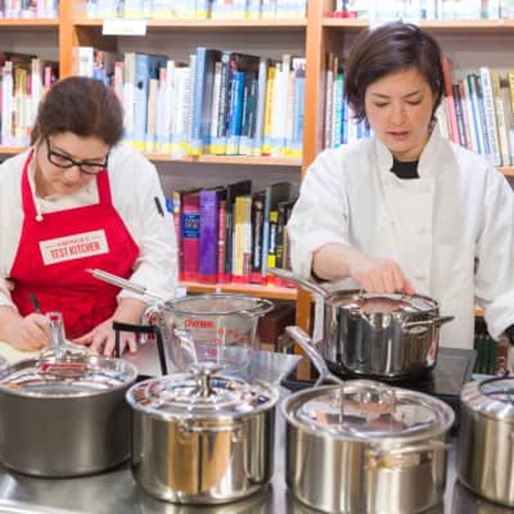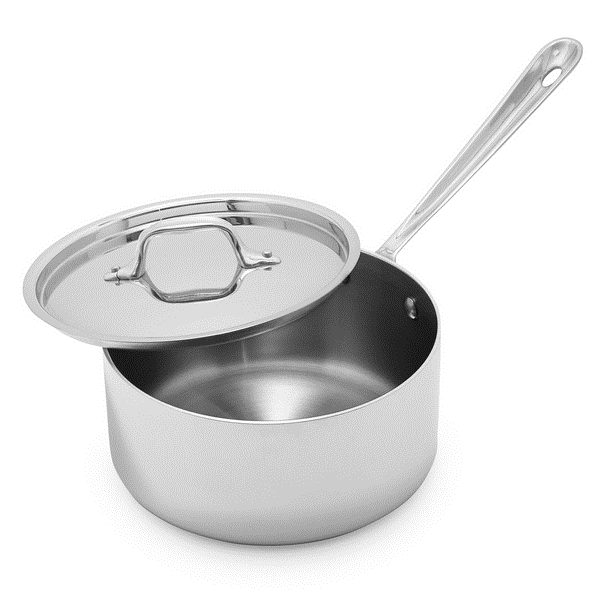The Differences Between Good and Bad Saucepans
Cookware doesn’t get much simpler than a saucepan: It’s basically a bowl with a handle and a lid. But it also doesn’t get more important, since this is the vessel used to prepare everything from soups and sauces to pasta and grains to custards and puddings.

So you want a pan that can perform. But when it comes to performance, the folks at America’s Test Kitchen (ATK) found that the differences between good and bad saucepans can be surprisingly significant.

Well-designed saucepans sear, simmer, and steam at a steady, controlled pace; handle comfortably, even when full; and boast tight-fitting lids and stay-cool handles that eliminate the need for a potholder.
But there are duds out there that make cooking uncomfortable, time-consuming, and messy. Flimsy, warped vessels have scorching hot spots; Heavy frames and wiggly handles make a saucepan a bear to lift when full. And pesky handle rivets trap food and make cleanup a chiseling project rather than a quick swipe with a sponge.
The bottom line to all this is that saucepans are the cornerstone of a fully equipped kitchen and they can make or break your meals. So it’s worth getting a good one. But since they’re not created equal, you need to know what to look for. Here’s some trustworthy guidance from Sawyer Phillips, an ATK researcher:

THE PAN SHOULD FEEL STURDY AND EVENLY BALANCED. Always look for sturdy construction, meaning the pan feels balanced when lifted. Although a pan should have a good weightiness, be sure it’s not too heavy—it will only get heavier and harder to handle when filled.
THE INTERIOR SHOULD BE A LIGHT COLOR (not nonstick). A lighter-colored, stainless-steel interior will allow you to easily monitor browning, which is especially critical when you’re cooking something that can burn easily (such as browned butter).
THE LID SHOULD BE TIGHT-FITTING. This is essential, especially when you’re cooking something like rice that needs to steam evenly. Avoid glass lids—they usually fog up, making it hard to see through them. And skip the pour spout; it may seem like a handy feature, but it actually prevents the lid from sealing tightly.

THE HANDLE SHOULD FEEL SECURE. Faulty handles present risk of injury. It should be firmly attached (not wobbly) and not too skinny or round. It should feel anchored in your hand. A secondary helper handle is useful for moving the saucepan when it’s filled.
THE PAN SHOULD BE LABELED AS FULLY CLAD. “Fully Clad” means the pan is made up of three or more layers. These cook evenly and generally produce better results. While fully clad pans are typically labeled as such, the pan's design is another good indication. The point is, you want the pan to be the same thickness throughout.
And stay away from pans with a "disk bottom"; this usually means they have only a single layer of steel attached to the bottom, making it the thickest part of the pan, which will cause them to heat slowly and unevenly.
It’s true that fully clad pans are spendy, but the ATK testers have tested dozens of pots and pans over the years, and every time, they’ve concluded that fully clad cookware is worth the money. That’s because the cooking surface and walls are made of multiple layers of bonded metal—usually nonreactive, moderately heat-conductive stainless steel sandwiched around highly heat-conductive aluminum.
This construction (known as tri-ply when it’s three layers) heats evenly and reasonably quickly; it’s also more durable than single-ply aluminum or steel cookware, which tends to heat erratically, or disk-bottom cookware, where the fully clad portion is limited to the base of the pan, which allows food at the edges to cook faster and potentially burn.
Ultimately, the All-Clad brand Stainless 4-Qt Sauce Pan continues to prove why it has been—and still is—the ATK testers’ top pick. Consider their reasons:

Finally, America’s Test Kitchen pros have tested and used this sauce pan for almost a decade. They report it continues to survive rigorous testing with almost negligible dents, thus they’re convinced it’s not “just a flash in the pan!”

So you want a pan that can perform. But when it comes to performance, the folks at America’s Test Kitchen (ATK) found that the differences between good and bad saucepans can be surprisingly significant.

Well-designed saucepans sear, simmer, and steam at a steady, controlled pace; handle comfortably, even when full; and boast tight-fitting lids and stay-cool handles that eliminate the need for a potholder.
But there are duds out there that make cooking uncomfortable, time-consuming, and messy. Flimsy, warped vessels have scorching hot spots; Heavy frames and wiggly handles make a saucepan a bear to lift when full. And pesky handle rivets trap food and make cleanup a chiseling project rather than a quick swipe with a sponge.
The bottom line to all this is that saucepans are the cornerstone of a fully equipped kitchen and they can make or break your meals. So it’s worth getting a good one. But since they’re not created equal, you need to know what to look for. Here’s some trustworthy guidance from Sawyer Phillips, an ATK researcher:

THE PAN SHOULD FEEL STURDY AND EVENLY BALANCED. Always look for sturdy construction, meaning the pan feels balanced when lifted. Although a pan should have a good weightiness, be sure it’s not too heavy—it will only get heavier and harder to handle when filled.
THE INTERIOR SHOULD BE A LIGHT COLOR (not nonstick). A lighter-colored, stainless-steel interior will allow you to easily monitor browning, which is especially critical when you’re cooking something that can burn easily (such as browned butter).
THE LID SHOULD BE TIGHT-FITTING. This is essential, especially when you’re cooking something like rice that needs to steam evenly. Avoid glass lids—they usually fog up, making it hard to see through them. And skip the pour spout; it may seem like a handy feature, but it actually prevents the lid from sealing tightly.

THE HANDLE SHOULD FEEL SECURE. Faulty handles present risk of injury. It should be firmly attached (not wobbly) and not too skinny or round. It should feel anchored in your hand. A secondary helper handle is useful for moving the saucepan when it’s filled.
THE PAN SHOULD BE LABELED AS FULLY CLAD. “Fully Clad” means the pan is made up of three or more layers. These cook evenly and generally produce better results. While fully clad pans are typically labeled as such, the pan's design is another good indication. The point is, you want the pan to be the same thickness throughout.
And stay away from pans with a "disk bottom"; this usually means they have only a single layer of steel attached to the bottom, making it the thickest part of the pan, which will cause them to heat slowly and unevenly.
It’s true that fully clad pans are spendy, but the ATK testers have tested dozens of pots and pans over the years, and every time, they’ve concluded that fully clad cookware is worth the money. That’s because the cooking surface and walls are made of multiple layers of bonded metal—usually nonreactive, moderately heat-conductive stainless steel sandwiched around highly heat-conductive aluminum.
This construction (known as tri-ply when it’s three layers) heats evenly and reasonably quickly; it’s also more durable than single-ply aluminum or steel cookware, which tends to heat erratically, or disk-bottom cookware, where the fully clad portion is limited to the base of the pan, which allows food at the edges to cook faster and potentially burn.
Ultimately, the All-Clad brand Stainless 4-Qt Sauce Pan continues to prove why it has been—and still is—the ATK testers’ top pick. Consider their reasons:

- Its fully clad construction provides uniform and steady but efficient heat (it was one of the fastest to boil water and the quickest to return to a boil after food is added).
- Its light-colored interior and relatively broad cooking surface offered good visibility.
- Its hefty frame hits the sweet spot between sturdy construction and easy handling—they can lift it with one hand, even when it’s full.
- Its simple steel lid is durable, as is its stay-cool handle; it stays secure when gripped.
Finally, America’s Test Kitchen pros have tested and used this sauce pan for almost a decade. They report it continues to survive rigorous testing with almost negligible dents, thus they’re convinced it’s not “just a flash in the pan!”
 Alice Osborne
Alice Osborne
Weekly Newsletter Contributor since 2006
Email the author! alice@dvo.com
